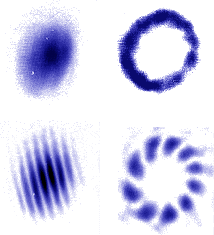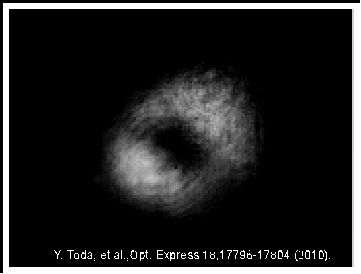TODA Group
Our group is a part of laboratory for Photo-electronic Materials.
Thank you for visiting. Please select the language ..... (English* or Japanese)
Research
BACK
Topological spectroscopy
 Vortex reminds you of eddy current and tornado (typhoon). If you are familiar with physics, you may associate it with quantum vortices in Bose-Einstein Condensations, superfulids and superconductors.
Vortices also occur in optical fields, which is so-called "optical vortices". In optical vortex, the vortex is characterized by the winding of phase on the wavefront. This characteristic can be confirmed by measuring the two-wave interference. The self-interference of the standard laser shows a fringe-pattern in radial direction while the vortex beams with opposite phase provide a fringe with a closed loop. The null intensity at the center is associated with a phase singularity.
Vortex reminds you of eddy current and tornado (typhoon). If you are familiar with physics, you may associate it with quantum vortices in Bose-Einstein Condensations, superfulids and superconductors.
Vortices also occur in optical fields, which is so-called "optical vortices". In optical vortex, the vortex is characterized by the winding of phase on the wavefront. This characteristic can be confirmed by measuring the two-wave interference. The self-interference of the standard laser shows a fringe-pattern in radial direction while the vortex beams with opposite phase provide a fringe with a closed loop. The null intensity at the center is associated with a phase singularity.
 The vortex-beam with helical wavefronts also indicates a transverse energy circulation, which is associated with an orbital angular momentum (OAM) per photon and is distinct from a spin angular momentum carried by a circularly-polarized light beam.
Since optical OAM allows to carry higher dimensions, optical vortices have potential for optical communications and information processing both in the classical and quantum regimes.
For practical use, the OAM transfer on ultrafast time-scale is necessary, which can be realized by using electrons in solids. Using optical four-wave-mixing process via semiconductor exciton, we demonstrated the ultrafast optical gate controls of OAM, which mark progress in the generation and control of sequential vortex pulses, and pave the way for the future opticalcommunications using multiple vortices.
The vortex-beam with helical wavefronts also indicates a transverse energy circulation, which is associated with an orbital angular momentum (OAM) per photon and is distinct from a spin angular momentum carried by a circularly-polarized light beam.
Since optical OAM allows to carry higher dimensions, optical vortices have potential for optical communications and information processing both in the classical and quantum regimes.
For practical use, the OAM transfer on ultrafast time-scale is necessary, which can be realized by using electrons in solids. Using optical four-wave-mixing process via semiconductor exciton, we demonstrated the ultrafast optical gate controls of OAM, which mark progress in the generation and control of sequential vortex pulses, and pave the way for the future opticalcommunications using multiple vortices.
 Recently, it was found that several quasi-one-dimensional (1D) transition metal chalcogenides can have various
types of closed-loop crystals.
Their 1D nature gives rise to chargedensity-wave (CDW) phase transitions driven by electron-phonon interactions. Since the correlation length of CDWs is on the order of several micrometers, the coherent CDWs within a closed-loop 1D chain provides an opportunity to investigate the characteristic quantum effects such as the Aharonov-Bohm effect. Using polarization vortex pulses, we realized a global evaluation of closed-loop CDWs in a ring-shaped quasi-1D crystal. The results verify that the CDW electrons in the ring maintain their 1D character, and so that the technique has the ability to evaluate the electron dynamics in closed-loop systems that plays an important role in the quantum correlation phenomena.
Recently, it was found that several quasi-one-dimensional (1D) transition metal chalcogenides can have various
types of closed-loop crystals.
Their 1D nature gives rise to chargedensity-wave (CDW) phase transitions driven by electron-phonon interactions. Since the correlation length of CDWs is on the order of several micrometers, the coherent CDWs within a closed-loop 1D chain provides an opportunity to investigate the characteristic quantum effects such as the Aharonov-Bohm effect. Using polarization vortex pulses, we realized a global evaluation of closed-loop CDWs in a ring-shaped quasi-1D crystal. The results verify that the CDW electrons in the ring maintain their 1D character, and so that the technique has the ability to evaluate the electron dynamics in closed-loop systems that plays an important role in the quantum correlation phenomena.